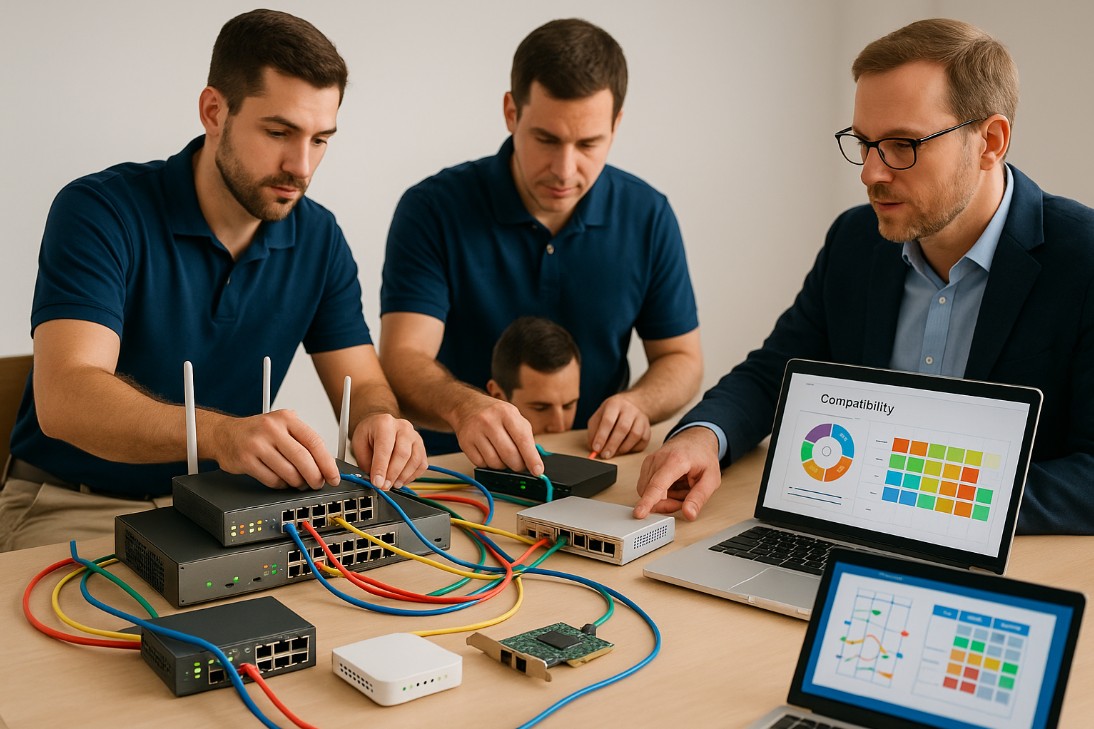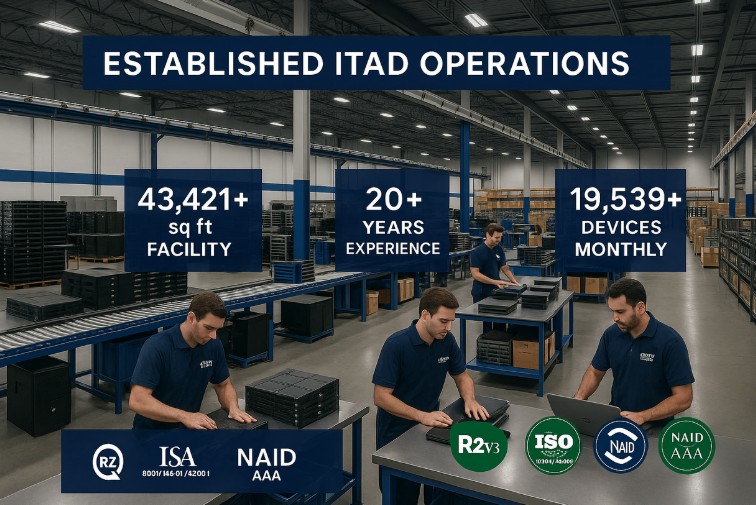A Fortune 500 company’s entire network infrastructure collapsed during a routine switch upgrade, bringing operations to a standstill for 18 hours and costing millions in lost revenue. The culprit was a seemingly minor compatibility issue between new managed switches and existing network interface cards that went undetected during planning.
The network hardware market is experiencing unprecedented growth, with research by Mordor Intelligence projecting expansion from $9.83 billion in 2020 to nearly $15.48 billion by 2026. This substantial growth brings both opportunities and challenges, as organizations must navigate an increasingly complex landscape of hardware components while ensuring seamless integration across their enterprise network environment.
Understanding network hardware compatibility has become essential for maintaining operational efficiency, security, and scalability in modern enterprise systems.
Key Components of Network Hardware
Enterprise network infrastructure relies on interconnected hardware components that must work in perfect harmony to deliver reliable connectivity and performance. Understanding these fundamental components and their compatibility requirements forms the foundation for building robust and scalable network systems.
Modern enterprise networks integrate multiple hardware types, each serving specific functions while maintaining compatibility with other network devices and systems.
Routers
Routers serve as the intelligent traffic directors of enterprise networks, making critical decisions about data packet routing and maintaining the routing tables that enable efficient communication across network segments.
Enterprise routers must support diverse connectivity requirements, including:
- Multi-protocol compatibility – Support for IPv4, IPv6, OSPF, BGP, and other routing protocols is essential for enterprise operations
- Interface diversity – Ethernet, fiber optic cables, T1 line connections, and emerging connectivity standards like 5G
- Quality of Service (QoS) capabilities – Traffic prioritization and bandwidth management for business-critical applications
- Security integration – Compatibility with hardware firewalls, virtual private networks (VPNs), and network security protocols
- Scalability features – Support for growing network demands and integration with cloud infrastructure services
Switches
Managed switches form the backbone of enterprise network connectivity, providing intelligent packet forwarding and network segmentation capabilities that enable efficient data flow throughout the organization.
Critical switch compatibility considerations include:
- Port configuration flexibility – Support for Gigabit Ethernet, fiber optic connections, and emerging standards like Wi-Fi 6
- Protocol support – Spanning Tree Protocol (STP), Link Aggregation Control Protocol (LACP), and network management protocols
- Power over Ethernet (PoE) capabilities – Compatibility with access points, IP phones, and other powered network devices
- Management interface compatibility – Integration with network monitoring tools, SNMP systems, and centralized management platforms
- Stacking and clustering support – Ability to work with other managed switches in high-availability configurations
Access Points
Wireless access points serve as critical bridges between wired network infrastructure and mobile devices, requiring seamless integration with existing network components while supporting evolving wireless standards.
Enterprise access point compatibility requirements include:
- Wireless standard support – Compatibility with Wi-Fi 6 and 6E, delivering approximately 30% faster performance than Wi-Fi 5.
- Network integration – Seamless connectivity with managed switches, WLAN controllers, and network management systems
- Security protocol compatibility – Support for WPA3, enterprise authentication systems, and network access control solutions
- Power and mounting compatibility – PoE requirements, physical mounting systems, and environmental considerations
- Management system integration – Compatibility with centralized wireless management platforms and network monitoring tools
Firewalls
Hardware firewalls provide essential security boundaries within enterprise networks, requiring deep integration with network infrastructure while maintaining compatibility with security policies and network protocols.
Firewall compatibility considerations include:
- Network protocol support – Comprehensive protocol inspection capabilities and compatibility with enterprise applications
- Integration capabilities – Seamless operation with routers, switches, and other network security components
- Performance scaling – Throughput capabilities that match network bandwidth requirements without creating bottlenecks
- Management interface compatibility – Integration with security information and event management (SIEM) systems
- High availability features – Clustering and failover capabilities that maintain network security during hardware maintenance
Importance of Compatibility in Network Hardware
Network hardware compatibility extends far beyond simple connectivity—it also affects performance optimization, security integration, and long-term operational sustainability. Organizations that prioritize compatibility considerations during network planning experience fewer operational disruptions and greater return on investment (ROI) on infrastructure investments.
Compatibility issues often arise in subtle ways that may only surface under high stress or during critical operations.
Performance Optimization Through Compatible Components
Hardware compatibility directly impacts network performance by enabling optimized data flow, reduced latency, and efficient resource utilization. When components are properly matched and configured, they can leverage advanced protocols and features that enhance overall system performance.
Compatible configurations enable:
- Protocol optimization – Efficient use of advanced networking protocols that improve data transmission and reduce overhead
- Bandwidth utilization – Optimal use of capacity through proper interface matching and traffic management
- Latency reduction – Lower processing delays with hardware capable of data forwarding
- Quality of Service (QoS) – Effective traffic prioritization and bandwidth allocation across compatible devices
- Load balancing – Distributed traffic handling across multiple components to prevent performance bottlenecks
Security Integration and Compliance
Network security relies on hardware compatibility to ensure consistent policy enforcement and support for enterprise-grade protocols. Incompatible hardware may introduce vulnerabilities or hinder compliance.
Security-focused compatibility considerations include:
- Uniform policy enforcement – Consistent access controls, traffic filtering, and security protocol application
- Encryption support – Compatibility with enterprise encryption standards and secure communication protocols
- Authentication integration – Seamless operation with identity management and access control systems
- Monitoring and logging consistency – Support for compatible formats and systems that provide full visibility
- Incident response coordination – Integration with centralized security systems for rapid threat detection and mitigation
The Role of Scalability in Network Hardware
Scalability represents a critical aspect of network hardware compatibility, allowing enterprise systems to accommodate growth, evolving technologies, and shifting business needs. According to IDC Research, over 50% of enterprises plan to increase their investments in network connectivity, underscoring the need for scalable, forward-compatible infrastructure.
Effective scalability planning requires a clear understanding of how current components will integrate with future upgrades and expansions.
Planning for Future Growth
Scalable hardware enables organizations to support increased traffic, user growth, and expanded functionality without requiring complete infrastructure overhauls.
Key considerations include:
- Modular architecture – Hardware that allows expansion via modules or add-ons without disrupting operations
- Bandwidth scalability – Support for increasing data throughput through interface or port upgrades
- Protocol evolution – Compatibility with emerging standards through firmware or software updates
- Management system scalability – Platforms that can monitor and manage a growing number of network devices
- Power and cooling capacity – Infrastructure that can accommodate added equipment without exceeding physical or energy constraints
Technology Evolution and Compatibility
Enterprise hardware must remain compatible with emerging technologies while maintaining seamless integration with existing systems. This balance requires evaluating vendor roadmaps, long-term support commitments, and flexible migration strategies.
Compatibility with evolving technologies includes:
- Software-defined networking (SDN) – Integration with centralized, programmable network architectures
- Cloud infrastructure – Seamless connectivity to hybrid and multi-cloud environments
- Edge computing – Support for decentralized processing near data sources
- Internet of Things (IoT) enablement – Integration with large volumes of smart devices and sensors
- AI-powered management – Compatibility with AI-driven optimization tools and automated network administration systems
Next-Generation Network Innovations
The networking landscape continues to evolve rapidly, with emerging technologies reshaping how organizations design, implement, and manage enterprise networks. Understanding these innovations and their hardware compatibility requirements helps organizations make informed decisions about infrastructure investments.
While next-generation networking offers significant performance and agility benefits, it also introduces new compatibility challenges that must be managed strategically.
Software-Defined Networking (SDN)
Software-defined networking represents a fundamental shift in network architecture by separating the control plane functions from the data plane, enabling centralized network management and programmable infrastructure.
Key SDN compatibility requirements include:
- OpenFlow protocol support – Hardware that communicates effectively with SDN controllers and implements centralized policies
- Programmable interface capabilities – Devices that support APIs and allow programmable configuration management
- Performance optimization – Hardware that maintains high-speed data forwarding under SDN control
- Legacy system integration – Transitional compatibility that allows gradual SDN adoption without operational disruption
- Vendor ecosystem compatibility – Interoperability across SDN vendors and open-source platforms
Network Function Virtualization (NFV)
Network Function Virtualization replaces specialized hardware appliances with virtualized network services running on standard server infrastructure. This shift increases flexibility, scalability, and cost efficiency.
NFV compatibility considerations include: implementation requirements encompass
- Virtualization platform compatibility – Support for hypervisors like VMware, KVM, and Hyper-V
- Performance optimization – Sufficient CPU, memory, and I/O resources for high-throughput network functions
- Resource management – Dynamic allocation and scaling of virtualized services
- Integration capabilities – Seamless connection with existing network orchestration and monitoring tools
- Service chaining support – Ability to link virtualized services like firewalls, load balancers, and WAN optimizers
Comprehensive Network Hardware
Enterprise networks rely on more than just routers and switches. Supplementary hardware components provide essential functions and must be fully compatible with the core infrastructure to ensure performance and reliability..
Network Attached Storage (NAS)
Network Attached Storage systems offer centralized file sharing and data storage that must integrate effectively into the network environment. According to research, enterprise systems like 3Par StoreServ can deliver up to 8 times faster provisioning than non-flash alternatives and reduce capacity requirements by up to 75%.
NAS compatibility considerations include:
- Network protocol compatibility – Compatibility with SMB/CIFS, NFS, and enterprise file-sharing standards
- Performance optimization – Interface capable of delivering high-throughput access for users and applications
- Security integration – Support for encryption, enterprise authentication, and access controls
- Backup and replication support – Seamless integration with disaster recovery systems
- Management system compatibility – Visibility through centralized network and storage monitoring tools
Network Interface Cards (NICs)
Network interface cards provide the physical link between servers, workstations, and network infrastructure. Their compatibility influences bandwidth utilization, system responsiveness, and advanced network features.
NIC compatibility factors include:
- Speed and duplex matching – Proper alignment with switch port speeds and network capacity
- Driver compatibility – OS support for Windows Server, Linux, and virtualization platforms
- Advanced feature support – Compatibility with VLAN tagging, jumbo frames, and offloading features
- Power management – Support for Wake-on-LAN and system-level power saving
- Virtualization readiness – Integration with virtual machine and hypervisor networking environments
Enhancing Operational Efficiency with Network Hardware
Operational efficiency in enterprise networking depends on hardware compatibility that supports streamlined management, automation, and consistent performance. Organizations that prioritize compatibility when selecting hardware reduce administrative overhead, improve service reliability, and enable long-term scalability.
Efficient network operations require hardware that integrates seamlessly with management systems and supports automation initiatives across the infrastructure.
Automation and Management Integration
Modern network hardware must support automation to reduce manual configuration tasks, ensure consistency, and accelerate network deployment and scaling.
Key automation-ready hardware features include:
- API availability – Application programming interfaces for automated configuration, monitoring, and updates
- Configuration management compatibility – Integration with infrastructure-as-code tools like Ansible, Puppet, or Chef
- Standardized protocol support – SNMP, NETCONF, RESTCONF, and other widely adopted network management protocols
- Template and policy support – Ability to apply standardized templates and configuration policies across devices
- Integration capabilities – Integration with centralized management platforms and automated provisioning systems
When organizations need to upgrade or replace network hardware, Refurbishment & Redeployment services offer reconditioned, tested components that maintain performance and compatibility. For broader IT asset management, Corporate IT Asset Disposition services ensure secure handling and environmentally responsible recycling of retired network hardware, while maximizing asset value.
Building Resilient, Compatible Enterprise Networks
As enterprise networks grow in scale and complexity, hardware compatibility becomes a foundational requirement for performance, security, and operational efficiency. From routers and switches to access points, firewalls, and storage systems, each component must function cohesively within a unified infrastructure.
OEM Source helps enterprise IT leaders navigate the complexity of network infrastructure with certified refurbished equipment, end-to-end asset lifecycle services, and expert support for hardware compatibility. Whether you’re upgrading key systems or building from the ground up, our team ensures your network is built to perform.
Frequently Asked Questions
What are the hardware requirements for network connectivity?
Network connectivity requires compatible network interface cards (NICs), appropriate cabling (such as Ethernet cables or fiber optic), switches or routers that support necessary protocols. Requirements vary based on bandwidth demands, device types, and physical distance between endpoints.
What is a Hardware Compatibility List (HCL)?
A Hardware Compatibility List (HCL) is a verified list of hardware components tested to work together in specific configurations. It helps IT teams improve compatibility between servers, storage systems, and networking devices during procurement or upgrade planning.
What are the 4 network hardware?
The four fundamental types of network hardware are:
- Routers (for traffic routing between networks)
- Switches (for connecting devices within networks)
- Access points (for wireless connectivity)
- Firewalls (for network security)
What are the 7 pieces of network hardware?
The seven commonly used network hardware components are:
- Routers
- Switches
- Access points
- Firewalls
- Network interface cards
- Modems
- Cables.
Additional components like NAS, load balancers, and monitoring devices may also be essential, depending on infrastructure complexity.
How do you ensure network hardware compatibility during upgrades?
To ensure hardware compatibility during network upgrades, start with a comprehensive audit of existing infrastructure and consult the manufacturer’s Hardware Compatibility Lists (HCLs). Verify interoperability across components, especially between new and legacy systems and test critical integrations in staging environments before deployment. Collaborating with a trusted hardware partner like OEM Source can also reduce compatibility risks and streamline upgrade planning.





